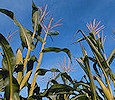
A current country song says 'Rain makes corn, and corn makes whiskey.' It may be a 'corny' song, but rain when it's not in excess does make corn. Heat in excess doesn't. One reason yields literally busted through the roof a year ago was the super-cool July weather. It was one of the coolest July months in weather history on record in Indiana. This year July was in the top 10 of the hottest July months on record.
People think that since we've had enough to too much rain, including rain through pollination, we should be looking at bin-buster yields. Tony Vyn, a Purdue University Extension specialist, says that's not necessarily so. In fact, the tillage expert, asked about the impact of hot, humid weather on corn last week, said above-trend lien guarantees aren't a sure thing, even with rain.
Those yields in Indiana and nationwide may come more into focus next week when USDA releases the first 2010 crop estimate, the August estimate. Indiana state ag statistician Greg Preston and Purdue ag economists will review the report at the Indiana state fair after it is released.
Daytime temperatures up to 86 degrees bolster photosynthesis, Vyn says. Temperatures above that don't. That's why 86 degrees is the top temperature used in typical Growing Degree Day formulas to determine how many heat units are available for corn each day.
Jim Newman, a former Purdue agronomist, speculated years ago that if nighttime temperatures are too high, corn plants don't handle sugars normally. The result can be some bushels knocked off the top end of yields.
Vyn carries it a step further. He says excessive daytime temperatures can actually reduce net photosynthesis vs. what happens at an optimum maximum of 86 degrees F. The end result is fewer sugars available to go into corn kernels. Then when nighttime temperatures are also too high, plants burn up more sugar on nighttime maintenance. Vyn says ideal nighttime temperatures in the middle of grain fill range from 60 to 65 degrees F. One report during the week of August 1st noted that it was 83 degrees at 3 a.m. one morning. That's tough weather for reaching the brass ring in 300-bushel or higher corn plots.
High temperatures helps explain why irrigators are often disappointed with their yields during hot summers, even though they provide adequate water throughout the season.
About the Author(s)
You May Also Like




